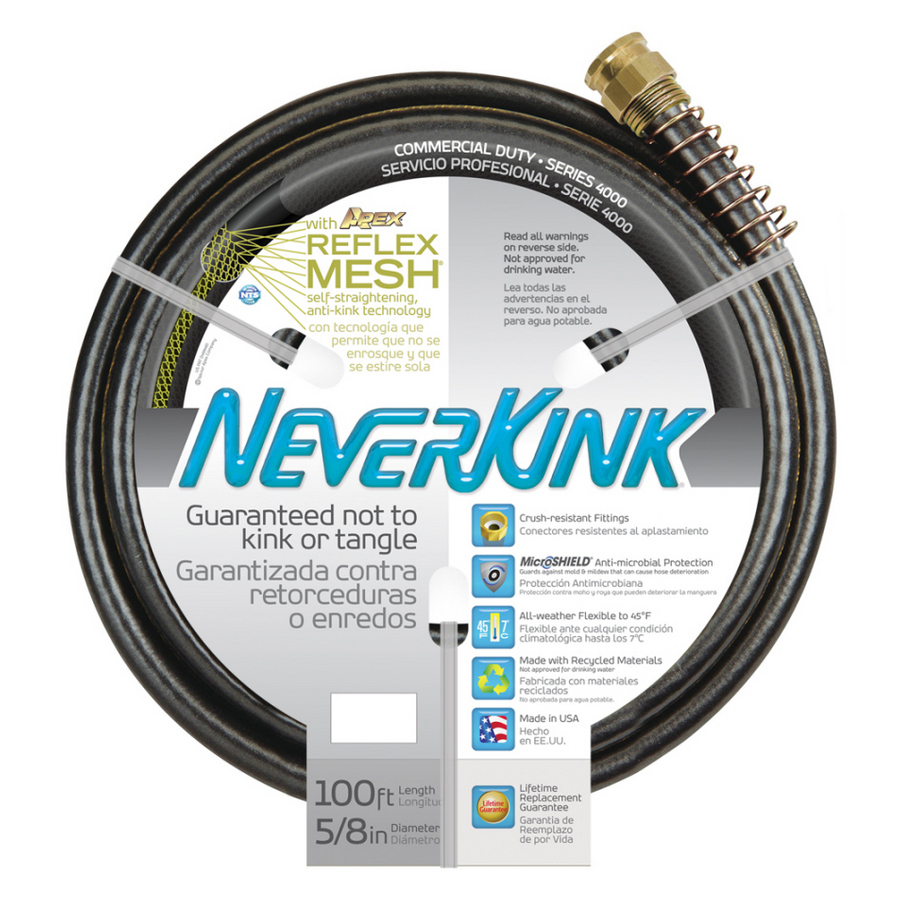Garden hose is a staple item. The gallons of water a hose will carry is determined by three factors-size, length and available water pressure. Most manufacturers have charts giving this information.
The inside diameter of the hose determines its efficiency.
Low-priced, promotional hoses, usually 1/2" diameter, deliver 9 gal. per minute (gpm), and higher quality hoses with 5/8" diameter deliver 17 gpm. A 3/4" hose delivers 23 gpm, almost three times what a 1/2" hose delivers. The larger the inside diameter of the hose, the less pressure loss over any distance. If the pressure is low (under 40 psi), the hose is running uphill, or is extra long, then the largest size hose available should be used to minimize pressure loss in the hose line.
To prevent premature cracking, hose should never be kinked or bent sharply either in use or in storage. Hose should be stored in season by coiling it on a wide bracket, hose hanger or reel, never by hanging it on a sharp nail or hook.
Before winter, drain all water from the hose, and then store it inside in coils. Use a small brush to clean out fittings threads prior to winter storage.
Never tug on hose when trying to eliminate a kink. This can cause the kink to permanently set in. Kinks should always be worked out by hand. Inexpensive hoses have a greater tendency to kink due to their thin walls, and frequently sprout leaks at those kink points.
Rubber Hose reinforced with tire cord fiber, generally nylon or polyester, and other additives has good resistance to weathering, cracking and ozone deterioration. A top quality hose can be shut off at the nozzle without bursting. Promotional lines have less reinforcement material.
Couplings should be full-flow, meaning internally expanded to maintain inside diameter for better water flow.
Most reinforced rubber hose can be used with hot water.
Rubber-Vinyl Hose - Although all rubber-vinyl hose is reinforced with tire cord fiber, there are two basic kinds in use.
One uses an expanded (or foamed) cover containing tiny air cells, similar to a fine sponge, giving it a softer feel, easier handling and more kink resistance.
The other has an extruded (non-foam) cover; it offers good flexibility but not as much as the expanded cover type. However, it is just as durable and has more dirt and abrasion resistance.
Vinyl Hose - "Reinforced vinyl" is the preferred generic name for vinyl hose, although a great deal of non-reinforced vinyl hose is sold.
The variables in vinyl hose include cover type (clear or opaque), reinforcement (knit or belted), foamed or non-foamed layers, wall thickness, burst-pressure rating and couplings.
Reinforcement is the primary factor in vinyl hose quality. Other factors, such as the tube compound material used in manufacturing, also affect the quality of the hose.
Burst-pressure rating depends most on reinforcement. Best quality hoses have two layers of belted bias radial or spiral and knit reinforcement.
Burst pressure should be at least four times the average faucet pressure to allow for surge pressures, use with pistol nozzles, etc. Burst strength depends upon the combination of reinforcement and the tube wall gauge. Lower-quality hoses typically have a burst rating of 200 psi, medium quality 275-350 psi, and high quality 350-500 psi.
Couplings should be internally expanded type to allow full inside diameter to be used; externally crimped couplings tend to restrict water flow.
"Wing connector nuts" make attaching hose to faucet very easy.
Non-reinforced vinyl hose is adequate for "open service" only and is suitable for use with rotary or oscillating sprinklers. Because of its low burst pressure, nozzles, pulsating sprinklers or any accessories with integral shut-off valves are not recommended.
Flat Hose lies flat until water pressure rounds it into 5/8" hose. A prime feature is that flat hose stores more easily and more compactly than conventional hose.
Flat hose must be completely extended before water will pass through it and it must be completely drained before storing.
There are two types of flat hose. One is made of a polyurethane liner and a tightly woven polyester jacket. The higher quality product has the liner bonded to the jacket to reduce kinking and leaking.
The other type is similar to conventional, reinforced vinyl hose, yet is flat when empty and expands when water is added. It is not as small as the first type but has excellent wear resistance and is half the size of conventional hose.
Once rounded, flat hose performs exactly like ordinary hose, delivering the same amount of water as a regular 5/8" hose. Weight is about one-third that of conventional hose; but because it is self-draining (provided the nozzle or sprinkler end is left open), it retains less water than ordinary hose (which may hold as much as 6 lbs. of water in each 50' length).
It requires 20 psi to round out (home water pressure is 40-60 psi) and is able to withstand normal treatment. Because it drains itself, it is less susceptible to freezing and cracking.
Flat hose will return to flat shape after repeated uses, will not wear on edges, will not crack around fittings and has comparable burst strength to conventional hose.
Some flat hose is packed in a cassette that holds the hose, allows it to be pulled out for use and retracts for storage. The cassette can be hooked to the water source for use and hung in garage or basement for storage. A hose cassette is ordinarily used only for handling and storage. If the hose remains in the cassette during use, the pressure of the expanding hose could damage it.
Dose this help?

